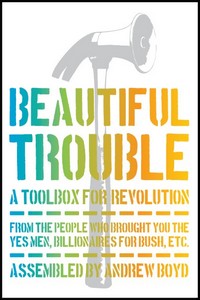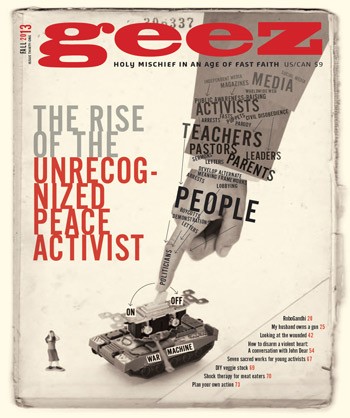Beautiful Trouble: A Toolbox for Revolution
Beautiful Trouble: A Toolbox for Revolution
Edited by Andrew Boyd and Dave Oswald Mitchell
OR Books, 2012
 The phrase “beautiful trouble” is not unlike Geez’s “holy mischief” tagline. Apparently, being troublesome and mischievous is sometimes beautiful and holy – think of overturning the tables of money-changers. Or, in the words of Martin Luther King Jr., quoted in the introduction to this book, “Human salvation lies in the hands of the creatively maladjusted.”
The phrase “beautiful trouble” is not unlike Geez’s “holy mischief” tagline. Apparently, being troublesome and mischievous is sometimes beautiful and holy – think of overturning the tables of money-changers. Or, in the words of Martin Luther King Jr., quoted in the introduction to this book, “Human salvation lies in the hands of the creatively maladjusted.”
This is not a book to be read from start to finish, but a reference tool for culture jammers and political pranksters. Politics blends with art, because art “really does enrich activism, making it more compelling and sustainable.”
This collection of “hybrid art/action methods,” written by 72 contributors, is organized into five different sections, each comprised of numerous two- to three-page entries in standardized format. Each entry is cross-referenced with related entries. Many are laced with pithy quotes like “The truth will set you free, but first it will piss you off” (Gloria Steinem), “If you don’t have a strategy, you’re part of someone else’s strategy” (Alvin Toffler) and “If you want to tell people the truth, make them laugh, otherwise they’ll kill you” (Oscar Wilde).
The “Tactics” section examines 30 specific forms of creative action, from classics like blockades and strikes to more recent developments like flash mobs and electoral guerrilla theatre (running for public office as a creative prank to make a point).
“Principles” introduces 52 hard-won insights that can guide or inform creative-action design, ranging from the obvious like “choose your target wisely” and “seek common ground,” to the insightful like “make the invisible visible” and “play to the audience that isn’t there.”
“Theories” summarizes 29 big-picture concepts useful for understanding how the world works and might be changed. Complex ideas from luminaries such as Bertolt Brecht (alienation effect), Antonio Gramsci (cultural hegemony), Claude Lévi-Strauss (floating signifier), Karl Marx (commodity fetishism), Richard Dawkins (memes), Paulo Freire (pedagogy of the oppressed), Noam Chomsky (propaganda model) and Naomi Klein (shock doctrine) are distilled for the practical needs of revolutionaries on the ground.
“Case Studies” has 33 stories of instructive actions to illustrate how principles, tactics and theories can be successfully applied in practice. They range from historic events such as Gandhi’s Salt March and the Battle in Seattle, to more recent, lesser-known actions such as Billionaires for Bush (editor Andrew Boyd’s pet project) and Stephen Colbert’s roast of George W. Bush at the White House Correspondents’ Association Dinner in 2006 (view it on YouTube).
“Practitioners” identifies 49 people and groups that inspire us to be better changemakers (naked celebrity PETA stunts not included).
The overall pattern of entries tilts toward media-dependent shenanigans that create spectacles and away from the invisible everyday drama of Shane Claiborne’s suggestion of “living as an ordinary radical.” Few people have the means, access and nerve for more. And the nigh-triumphalist tone would be tempered by viewing a documentary such as If a Tree Falls: A Story of the Earth Liberation Front. Nevertheless, this is an informative and inspiring how-to handbook of direct, confrontational social activism that has real political and social impact. There’s no mere slacktivism here. No low-risk, low-cost, feel-good “liking” on social media mixed with hipster consumerism. This is a primer for those ready and sturdy enough to take real action.
Can’t wait to get your hands on a copy of the book? Don’t need to. All the contents and more are at beautifultrouble.org, where you can add your own tactic, principle, theory or case study according to their templates and help fuel the revolution(s).



Sorry, comments are closed.